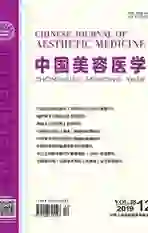应用CBCT评估“根膜种植牙”术后唇侧骨量变化
2019-12-24谭蕾孙聪
谭蕾 孙聪
[摘要]目的:评估美学区单颗牙“根膜种植技术”与I型即刻种植术后6个月唇侧牙槽骨尺寸变化。方法:根据纳入排除标准共选入30例患者,采用随机数表法分为实验组行“根膜种植牙技术”(n=15)和对照组行传统不翻瓣即刻种植型即刻种植(n=15),利用锥形束CT(Cone beam computed tomography,CBCT)评估分析两组美学区单牙种植术后6个月种植牙唇侧牙槽骨板尺寸的变化。结果:术后6个月两项指标平均值分别:实验组厚度(1.15±0.27)mm ,对照组厚度(0.83±0.13)mm;实验组高度(2.59±0.21)mm ,对照组高度(1.82±0.18)mm,术后6个月单牙唇侧牙槽骨高度和厚度两组平均尺寸变化比较,均有统计学差异(P>0.05)。结论:采用“根膜种植牙技术”一定程度上减少了在自然愈合中发生的颊侧骨板的吸收,对美学区单颗牙唇侧骨板有相对理想的保存效果。
[关键词]种植牙;根膜技术;拔牙窝;唇侧牙槽骨;美学区域;即刻种植
[中图分类号]R782.12 [文献标志码]A [文章编号]1008-6455(2019)12-0102-04
Use CBCT to Contrastive Analyze the Impact on Side Dental Lamina Size of Socket- shield Techniques
TAN Lei, SUN Cong
(Department of Stomatology, the First Affiliated Hospital of Xian Jiaotong University, Xian 710061,Shaanxi,China)
Abstract: Objective To analyze the impact on side dental lamina size of the front single teeth between socket-shield techniques and flap-less I type immediate implant after six months. Methods There are 30 patients are selected according to the inclusion and exclusion criteria, adopting random number table to divided into testing team to socket-shield techniques(n=15)and conservatively team to I type immediate implant(n=15), use CBCT to evaluate and conservatively analyze the impact on side dental lamina size of the front single teeth in two aesthetics area after six months. Results The average values of the two indexes were six months after operation: thickness of the experimental group (1.15±0.27)mm vs control group thickness(0.83±0.13)mm, height of the experimental group (2.59±0.21)mm vs height of the control group (1.82±0.18)mm , There is statistic difference for the average change for the height and thickness lip side alveolar bone between two teams after six months operation(P>0.05). Conclusion The research shows that socket-shield technique which can reduce buccal bone plate the absorption during the natural healing. There is an ideal saving effect to single tooth buccal bone plate in aesthetic area.
Key words: dental implant; socket- shield technique; extraction socket; labial alveolar bone; aesthetic area; immediate implant
美學区种植已经发展到不仅需要关注种植体-骨结合作用,更需要达到理想稳定的美学效果以满足患者的要求和期望。拔牙后唇侧牙槽骨会出现明显改建[1-3],显著增加了唇侧牙龈退缩的风险,面对患者日益增加的美学要求,不少学者提出了各种拔牙位点保存方法来改善拔牙后牙槽骨改建,以往研究数据表明即刻种植并不能有效阻止颊侧束状骨板的改建[4],甚至出现更多的唇侧骨吸收[5-6]。Paolantoni和Covani等发现单纯即刻种植不能完全阻止牙槽骨改建,其减缓牙槽骨吸收的效果也不确切。为减少美学区唇侧骨板吸收,Hürzelere[7]提出 “根膜技术”,采用此原理的目的是通过保留部分牙根来保存种植体颊侧边缘的牙周组织。此外,Davarpanah 和 Szmukler-Moncler[8]在5例患者的研究中报道,与粘连牙根结构共同存在的种植体在负重后12~24个月内没有出现任何特殊的病理症状。目前为止,仍然没有充分的临床证据证明“根膜技术”可以改善美学区单颗牙唇侧牙槽骨板的改建,本研究采用了前瞻性随机对照临床试验,通过CBCT对比分析“根膜技术”(保留唇侧牙片)和传统不翻瓣即刻种植型即刻种植术对美学区单颗牙唇侧骨板尺寸变化的影响,现将结果报道如下。
1 资料和方法
本研究获得西安交通大学第一附属医院机构审查委员会的批准(批准号:2016188),根据纳入排除标准共入选30例患者,采用随机数表法分为实验组行“根膜技术”(n=15)和对照组行传统不翻瓣即刻种植型即刻种植(n=15),所有研究对象在西安交大一附院口腔科种植中心进行种植手术治疗,整个疗程遵守赫尔辛宣言中关于临床实验的规定。
1.1 排除及纳入标准:纳入标准:①医学健康成人,男、女性年龄均大于25岁,非吸烟者;②无法保留的前牙且其近远中邻牙存在;③术前诊断为颊侧牙周组织完整,牙周表型(中等或者厚)[9];④良好的口腔环境,无未受控制或未经治疗的牙周疾病;⑤自我评估记录显示,患者具有良好的医疗和心理健康,并可配合随访。排除标准:①目前/过去有牙周病;②颊侧骨板有垂直向吸收;③其他影響颊侧牙根的病因,如非根尖因素的内或外吸收;④怀孕,计划怀孕或者哺乳期的患者;⑤未签署知情同意书者。
1.2 手术和修复过程:具体见图1。局麻下,在牙龈下1mm用金刚石钻头纵向截断临床牙冠,用微创牙龈分离器分离腭侧根牙周韧带后,用牙钳夹出腭侧牙片,牙根剩余的部分使用黄标车针进行打磨抛光,过程中避免在颊侧组织上施加压力。最终在牙槽窝颊侧骨壁上保存了一部分牙片,从垂直方向上看,牙片的冠部位于颊侧骨壁水平上方1mm处。然后根据制造商的指南进行种植窝的预备植入相应的种植体并与唇侧牙片轻微接触。过程中必须特别注意保持钻头在垂直向上的稳定。在预备若牙根薄片在制作过程中脱落或松动,将其牙片取出,随后将采用常规种植体植入术。图2为Simplant软件模拟种植体和牙片的位置。因为采用不翻瓣术式,所以术后行即刻临时冠修复,并给予患者完整的术后指导和建议的口服用药。
1.3 测量唇侧骨板高度变化:利用锥形束投照计算机重组断层评估分析两组美学区单牙种植术后6个月种植牙唇侧牙槽骨板尺寸的变化(见图3)。在CBCT纵向截面图像上,在所保留牙片的表面做一条平行于唇侧骨板的直线L1,以此线为基线测量唇侧骨板厚度,选取种植体表面第五螺纹相对应的骨板厚度代表唇侧骨板的平均厚度。测量方法:在平行基线上,选取第五螺纹(L2)所对应的点A,在A点做基线的垂线L3,测量唇侧骨板厚度如图2所示。在种植体肩台处做一直线,如图3中的红线所示,然后在唇侧牙槽嵴顶处作此直线的垂线,分别在术后即刻和术后6个月时,测量垂线的距离,分别为H0和H1,若牙槽嵴顶位于直线的冠方,则数值为正,若位于根方,则为负;则术后6个月唇侧骨板高度的变化为H0-H1。
1.4 统计学分析:所有检验均采用SPSS18.0进行数据统计分析。患者基本情况和主要基线数据采用频数(构成比)表示。计量资料以均数±标准差(x?±s)表示。对符合正态分布的实验组和对照组各项统计数据采用t检验进行统计分析,对非正态分布的实验组和对照组各项统计数据采用t检验进行统计分析,计数资料以率(%)表示,采用χ2检验。
2 结果
术后即刻,种植体稳定性系数平均值:试验组76.01±1.31,对照组75.56±1.07,两组比较,P=0.311,无统计学差异;术后6个月两项指标平均值分别为,实验组厚度(1.15±0.27)mm,对照组厚度(0.83±0.13)mm;实验组高度(2.59±0.21)mm,对照组高度(1.82±0.18)mm,术后6个月单牙唇侧牙槽骨高度和厚度两组平均尺寸变化之间均有统计学差异(P<0.05)。
3 讨论
本研究共招募30例患者(20女/10男),植入30颗种植体,两组术后即刻稳定性系数平均值分别为75.01±1.31(试验组)和75.56±1.07(对照组)(P>0.05),共振频率分析(RFA)是目前国际上评估种植体稳定性的可靠方法[10-13],种植体的ISQ>60被认为是可以行即刻负重的目标参数,可进行即刻修复而不影响种植体的骨结合。
在美学区完全保存或改建种植体周围的软组织仍是种植领域的难题,它通常只能在特定病例中实现。美学缺陷表现为颊侧正中或牙间的垂直退缩、水平向的颊侧轮廓减小。这些变化可能与拔牙造成的影响因素相关,如机械创伤,暴露于口腔的拔牙窝内微生物,翻瓣导致的骨膜血供中断,患者相关的危险因素(吸烟或菌斑堆积等)。文献指出颊侧骨壁厚度和牙周组织丧失是两个非常重要的病因[14-15]。为了防止破环种植体的美观和骨结合,学者们通过牙槽嵴保存术和支持性措施来尽可能地获得最佳美学效果。这些措施包括软组织增量术、即刻修复、不翻瓣种植、种植体偏腭向以及平台转移[16-18]。尽管这些技术都有积极作用,但他们只在特定病例中才达到理想的美学效果[19-22],这是因为它们无法完全阻止或补偿组织改变[19]牙周韧带和束状骨的吸收与种植体周围软组织退缩和美学缺陷密切相关[23-24]。
目前尚未有研究报道关于牙槽窝唇侧骨板的完整保存或者完全再生的病例,本研究利用CBCT评价前牙区单牙根膜种植技术改善前牙区唇侧牙槽骨板改建的临床效果,零假设是两个研究组之间没有差异。利用CBCT对比分析两组在前牙区单颗牙种植术后6个月唇侧牙槽骨板高度和厚度尺寸的变化,两组在基线时骨板的高度和厚度(唇侧牙槽骨基线期厚度均大于1mm)无统计学差异,两组术后6个月骨板高度及厚度变化均存在统计学差异(P<0.05)。I型即刻(对照组)种植术后6个月与基线期相比颊侧骨板高度平均降低了约0.87mm,骨板厚度平均减少了0.53mm,以往临床研究[25-28]和动物实验研究[29-30]解释为牙齿拔出后,颊侧牙槽骨会发生显著吸收并且颊侧比腭/舌侧的骨吸收更显著,即刻种植无法弥补骨改建[31-32]。本研究中所观察到对照组中颊侧骨板的吸收高于以往研究的结果。这种结果偏高的原因可能跟本试验纳入的种植体位点全部为前牙区域:其拔牙位点为中切牙,侧切牙有关。比较实验组基线与术后6个月数据颊侧骨板高度平均降低了0.28mm,牙槽骨厚度平均减少0.22mm。
本研究结果发现实验组术后6个月内牙槽骨高度和厚度尺寸平均变化明显低于对照组。这可能与解剖结构上前牙唇侧骨板厚度较薄,该美学区的骨通常都是由皮质骨组成有关。天然牙颊侧骨板的血供主要来源于牙周膜、骨髓和外部黏骨膜,并且牙根-牙周韧带-牙槽骨紧密贴合构成复合体,而拔牙创伤会导致复合结构丧失,颊侧骨板失去牙周膜来源的血供,仅存在骨膜来源的血供。动物实验研究发现[30]天然牙拔除后,构成牙槽窝骨壁的束状骨受到牙周膜纤维切断的影响,牙槽骨血供也同时被切断,不可避免地发生束状骨组织的改建,因此导致了牙槽嵴水平向的明显吸收。所以,本研究实验组通过保留了唇侧部分牙根,从而保全了唇侧骨板的牙周韧带和血液供应,防止了唇侧皮质骨的过度改建,而对照组失去天然牙所具有的解剖结构,导致了皮质骨的过度改建,唇侧骨板的吸收相对明显。
本研究在样本量纳入时为了避免美学风险,所有纳入研究的患者前牙位点唇侧骨板厚度均大于1mm,通过表3发现把两组前牙唇侧骨板厚度设定以1.2mm、1.3mm为界时两组人数相对均衡,发现对照组牙槽骨板的厚度与高度吸收程度变化成正相关关系,即对照组随着牙槽骨板厚度增加牙槽骨高度吸收程度也相应减少,反之亦然。然而实验组牙槽骨厚度在设定值为1.2mm、1.3mm时,未发现颊侧牙槽嵴厚度与颊侧牙槽骨高度吸收程度有相关性,从本研究中发现这种现象也由此支持上述实验组即在种植体和唇侧新鲜拔牙窝骨壁间保留部分唇侧牙片一定程度保全了唇侧骨板的牙周韧带和血液供应,防止了唇侧皮质骨的改建,相对减少了在自然愈合中发生的颊侧骨板厚度和高度的吸收,骨板吸收量明显低于对照组。
4 结论
本研究表明即刻种植并不能完全避免术后牙槽嵴的改建吸收,而“根膜种植牙技术”却能有效保存唇侧骨板尺寸,为临床解决前牙美学难题提供了新思路。然而大家還应谨慎解读这一研究结果,因为对于有高美学风险的患者在即刻种植体植入后的长期美学效果的评估仍然是缺乏的。
[参考文献]
[1]Amler M,Johnson PL,Salman I.Histologic and histochemical investigation of human alveolar socket healing in undisturbed extraction wounds[J].J Am Dent Assoc,1960,61:46-48.
[2]Schropp L,Wenzel A,Kostopoulos L,et al.Bone healing and soft tissue contour changes following single-tooth extraction:a clinical and radiographic 12-month prospective study[J].Int J Periodontics Restorative Dent,2003,23(4):313-323.
[3]Fickl S,Zuhr O, Wachtel H,et al.Dimensional changes of the alveolar ridge contour after different socket preservation techniques[J].J Clin Periodontol,2008,35(10):906-913.
[4]Pietrokovski J,Massler M.Alveolar ridge resorption following tooth extraction[J].J Prosthet Dent,1967,17(1):21-27.
[5]Arau?jo MG,Lindhe J.Dimensional ridge alterations following tooth extraction.An experimentalstudy in the dog[J].J Clin Periodontol,2005,32(2):212-218.
[6]Botticelli D,Berglundh T,Lindhe J.Hardtissue alterations following immediate implant placement in extraction sites[J].J Clin Periodontol,
2004,31(10):820-828.
[7]Hürzeler MB,Zuhr O,Schupbach P,et al.The socket-shield technique:a proof-of-principle report[J].J Clin Periodontol,2010,37:855-862.
[8]Davarpanah M,Szmukler-Moncler S.Unconventional implant treatment I. Implant placement in contact with ankylosed root fragments A series of five case reports[J].Clin Oral Implant Res,2009,20(8):851-856.
[9]De Rouck T,Eghbali R,Collys K,et al.The gingival biotype revisited: Transparency of the periodontal probe through the gingival margin as a method to discriminate thin from thick gingiva[J].J Clin Periodontol, 2009,36(5):428-433.
[10]Cook DR,Mealey BL,Verrett RG,et al.Relationship between clinical periodontal biotype and labial plate thickness: an in vivo study[J].Int J Periodontics Restor Dent,2011,31(4):345.
[11]Kehl M,Swierkot K,Mengel R.Three-dimensional measurement of bone loss at implants in patients with periodontal disease[J].J Periodont,2011, 82(5):689-699.
[12]Fienitz T,Schwarz F,Ritter L,et al.Accuracy of cone beam computed tomography in assessing peri-implant bone defect regeneration:a histologically controlled study in dogs[J].Clin Oral Implant Res,2012,23(7):882-887.
[13]Roe P,Kan JY,Rungcharassaeng K,et al.Horizontal and vertical dimensional changes of peri-implant facial bone following immediate placement and provisionalization of maxillary anterior single implants: a 1-year cone beam computed tomography study[J].J Oral Maxillofac Implant,2012,27(2):393-400.
[14]Degidi M,Daprile G,Nardi D,et al.Buccal bone plate in immediately placed and restored implant with Bio-Oss(?) collagen graft: a 1-year follow-up study [J].Clin Oral lmplant Res,2013,24(11):1201-1205.
[15]Tan WL.A systematic review of post extractional alveolar hard and soft tissuedimensional changes: comparison of animal andhuman studies[J].Clin Oral lmplant Res,2012,23(s5):1-21.
[16]Schropp L,Wenzel A,Kostopoulos L,et al.Bone healing and soft tissue contour changes following single-tooth extraction:a clinical and radiographic 12-month prospective study[J].Int J Periodontics Restor Dent,2003,23 (4):313.
[17]陳进英,陈东,黄建生.即刻种植的临床研究[J].中国口腔种植学杂志,2004,9(2):69-71,74.
[18]H?mmerle CH,Chen ST,Wilson TG Jr,et al.Consensus statements and recommended clinical procedures regarding the placement of implants in extraction sockets[J].Int J Oral Maxillofac Implant,2004,19(Suppl):26-28.
[19]Di Giacomo GA,Cury PR,de Araujo NS.Clinical application of stereolithographic surgical guides for implant placement: preliminary results[J].J Periodont, 2005,76(4):503-507.
[20]Botticelli D,Berglundh T,Lindhe J.Hard-tissue alterations following immediate implant placement in extraction sites[J].J Clin Periodontol,2004,31(10):820.
[21]Covani U,Bortolaia C,Barone A,et al.Bucco-lingual crestal bone changes after immediate and delayed implant placement[J].J Periodont,2004,75(12):1605.
[22]De Rouck T,Collys K,Cosyn J.Single-tooth replacement in the anterior maxilla by means of immediate implantation and provisionalization: a review[J].Int J Oral Maxillofac Implant,2008,23(5):897-904.
[23]Ludlow JB,Davies-Ludlow LE,Brooks SL,et al. Dosimetry of 3 CBCT devices for oral and maxillofacial radiology: CB Mercuray, NewTom 3G and i-CAT[J]. Dento Maxillo fac Radiol,2006,35(4):219-226.
[24]Lofthag-Hansen S,Thilander-Klang A,Ekestubbe A.Calculating effective dose on a cone-beam CT-device: 3D Accuitomo and 3D Accuitomo FPD[J].Dento Maxillofac Radiol,2008,37(2):72-79.
[25]Naitoh M ,Hirukawa A,Katsumata A,et al. Prospective study to estimate mandibular cancellous bone density using large-volume cone-beam computed tomography [J]. Clin Oral Implant Res,2010,21(12):1309-1313.
[26]Razavi T,Palmer RM,Davies J,et al.Accuracy of measuring the cortical bone thickness adjacent to dental implants using cone beam computed tomography [J].Clin Oral Implant Res,2010,21(7):718-725.
[27]Pietrokovski J,Massler M.Alveolar ridge resorption following tooth
extraction[J].J Prosthet Dent,1967,17(1):21-27.
[28]Schropp L,Kostopoulos L,Wenzel A.Bone healing following immediate versus delayed placement of titanium implants into extraction sockets: a prospective clinical study [J].Int J Oral Maxillofac Implants,2003,18(2):189-199.
[29]Araujo CR,Martinsjunior PA,Araujo RC.Narrow-implant-retained overdenture in an atrophic mandibular ridge:a case report with 6-year follow-up[J].General Dentistry,2015,63(6):e12.
[30]Araujo MG,Wennstr?m JL.Modeling of the buccal and lingual bone walls of fresh extraction sites following implant installation[J].Clin
Oral Implant Res,2006, 17(6):606.
[31]Blanco J,Suarez J,Novio S,et al.Histomorphometric assessment in human cadavers of the peri-implant bone density in maxillary tuberosity following implant placement using osteotome and conventional techniques[J].Clin Oral Implant Res,2008,19(5):505-510.
[32]Botticelli D,Berglundh T,Lindhe J.Hard-tissue alterations following immediate implant placement in extraction sites[J].J Clin Periodontol, 2004,31(10):820.
[收稿日期]2019-02-11
本文引用格式:譚蕾,孙聪.应用CBCT评估“根膜种植牙”术后唇侧骨量变化[J].中国美容医学,2019,28(12):102-106.
